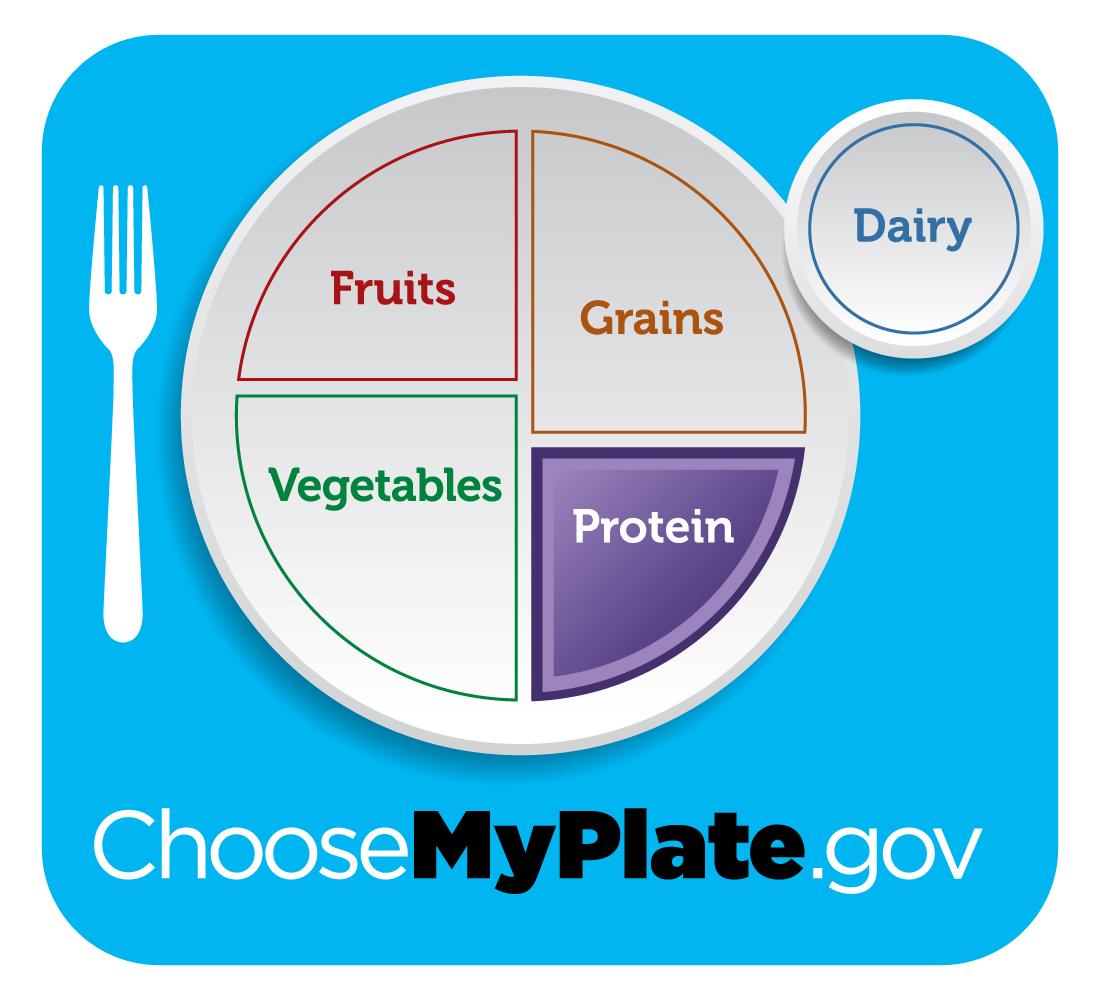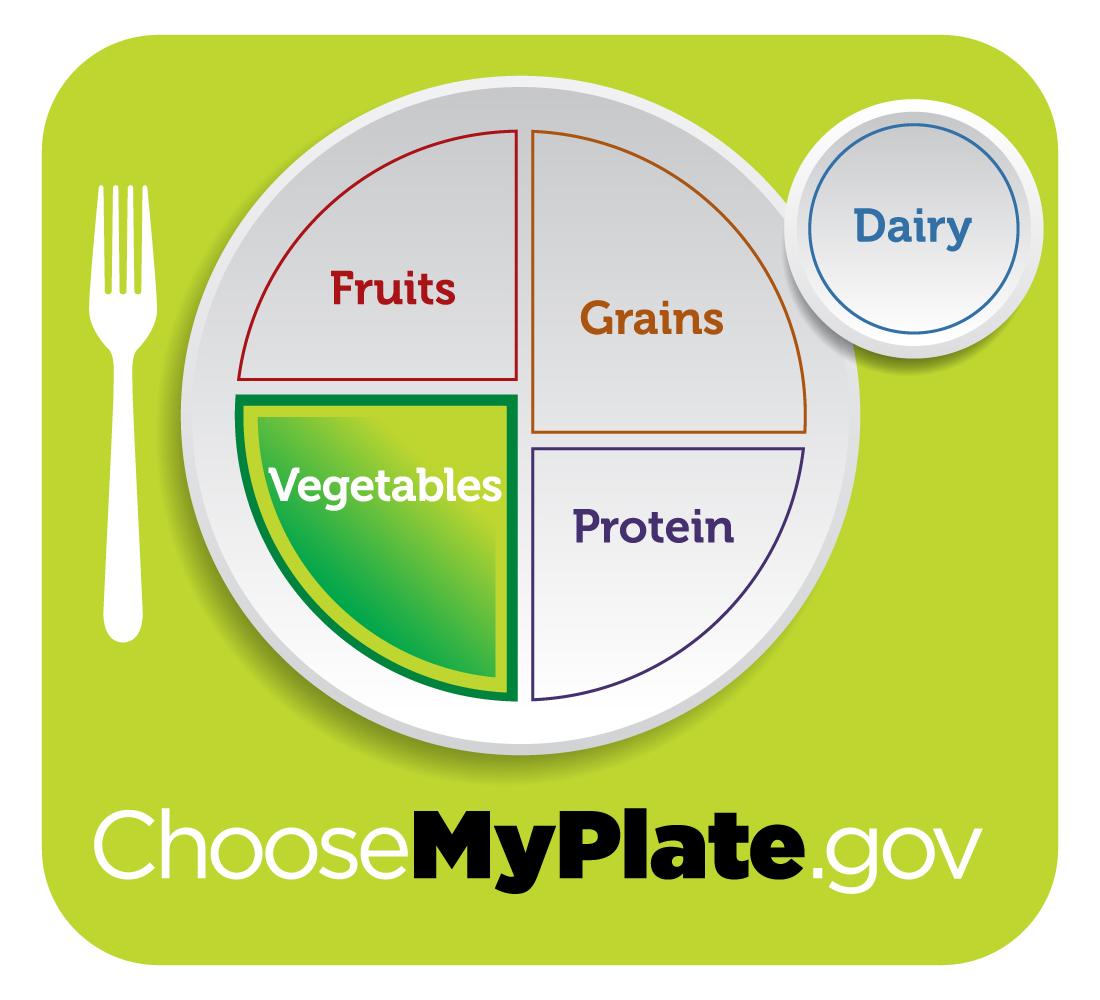8.2.2: Food Groups
- Page ID
- 67632
Milk Group
When selecting foods included in the milk group, low fat and fat-free choices should be made to promote good health. In general, 1 cup of milk, soy milk, yogurt, and 1 ½ ounces of cheese are considered a serving size (U.S. Department of Agriculture, 2015a).

U.S. Department of Agriculture (2015a) www.choosemyplate.gov)
Milk Sources:
- Milk (low fat, fat free, whole)
- Lactose-free and lactose-reduced milk
- Yogurt
- Pudding
- Ice cream
- Frozen yogurt
- Calcium fortified soy milk
- Hard cheeses (cheddar, mozzarella, swiss, parmesan)
- Soft cheeses (ricotta, cottage cheese)
- Calcium fortified juices and cereals
Recommended daily servings of milk products:
| Age | Daily serving | |
|---|---|---|
| 2-3 years old | 2 cups | |
| Children | 4-8 years old | 2 1/2 cups |
| 9-18 years old | 3 cups | |
| Women | 19+ years old | 3 cups |
| Men | 19+ years ole | 3 cups |
Source: U.S. Department of Agriculture (2015a)
Protein Foods Group
ChooseMyPlate.gov suggests selecting a variety of foods high in protein with 8 ounces of seafood per week. In general 1 ounce (oz.) of meat, ¼ cup of beans, 1 tablespoon of peanut butter, or ½ ounce of nuts or seeds are considered a serving of protein (U.S. Department of Agriculture, 2015a). You can view sources of protein by visiting choosemyplate.gov at http://www.choosemyplate.gov/foodgallery–protein–foods

U.S. Department of Agriculture (2015a) www.choosemyplate.gov)
Protein sources:
- Beef
- Pork (ham, pork chops)
- Lamb
- Veal
- Poultry (chicken, turkey)
- Beans (black, kidney, chickpeas, lentils, navy, pinto, white, soy beans, split peas)
- Eggs
- Canned fish (sardines, salmon, tuna, anchovies, clams)
- Fish (cod, tuna, sea bass, catfish, flounder, halibut, swordfish, trout, mackerel)
- Shellfish (shrimp, lobster, crab, mussels, oysters, scallops)
- Nuts (almonds, walnuts, hazelnuts, pistachios, peanuts, pecans)
- Seeds (sesame, pumpkin, squash, sunflower)
Recommended daily servings of protein:
| Age | Daily serving | |
|---|---|---|
| Children | 2-3 years old | 2 ounces |
| Children | 4-8 years old | 4 ounces |
| Girls | 9-18 years old | 5 ounces |
| Boys | 9-13 years old | 5 ounces |
| Boys | 14-18 years old | 6 1/2 ounces |
| Women | 19-30 years old | 4 ounces |
| Women | 31+ years old | 5 ounces |
| Men | 19-50 years old | 6 ounces |
| Men | 51+ years old | 5 1/2 ounces |
Source: U.S. Department of Agriculture (2015a)
Fruit Group
Most fruits are low in fat and all fruits have no cholesterol (U.S. Department of Agriculture, 2015a). Fruits are considered an important part of our diets and have many protective health benefits. Eating a diet high in fruits has been shown to reduce the risk of heart disease, some types of cancer, obesity, and type 2 diabetes (U.S. Department of Agriculture, 2015a). In general, 1 cup of fruit or fruit juices or ½ cup of dried fruit is considered a serving size from the fruit group (U.S. Department of Agriculture, 2015a).

Fruit Sources:
- Apples
- Apricots
- Bananas
- Blueberries
- Cantaloupe
- Cherries
- Fruit juices (100% fruit juice, all varieties)
- Grapefruit
- Grapes
- Kiwi
- Lemons
- Limes
- Mangoes
- Nectarines
- Oranges
- Papayas
- Peaches
- Pears
- Pineapples
- Plums
- Raisins
- Raspberries
- Strawberries
- Watermelon
Recommended daily servings of fruit:
| Age | Daily serving | |
|---|---|---|
| Children | 2-3 years old | 1 cup |
| Children | 4-8 years old | 1-1 1/2 cups |
| Girls | 9-18 years old | 1 1/2 cups |
| Boys | 9-13 years old | 1 1/2 cups |
| Boys | 14-18 years old | 2 cups |
| Women | 19-30 years old | 2 cups |
| Women | 31+ years old | 2 cups |
| Men | 19-51+ years old | 2 cups |
Source: U.S. Department of Agriculture (2015a)
Vegetable Group
Most vegetables are low in fat and all vegetables have no cholesterol (U.S. Department of Agriculture, 2015a). Vegetables are considered an important part of our diets and have many protective health benefits. Eating a diet high in vegetables has been shown to reduce the risk of heart disease, some types of cancer, obesity, and type 2 diabetes (U.S. Department of Agriculture, 2015a). In general, 1 cup of raw or cooked vegetables or 2 cups of leafy greens counts as one serving of vegetables (U.S. Department of Agriculture, 2015a).

Vegetable Sources:
- Artichokes
- Asparagus
- Bok choy
- Broccoli
- Celery
- Collard greens
- Corn
- Cucumbers
- Green lima beans
- Green peas
- Lettuce
- Kale
- Mushrooms
- Mustard greens
- Onions
- Peppers (green, red, orange, yellow)
- Potatoes
- Spinach
- Squash (all varieties)
- Sweet potatoes
- Taro
- Tomatoes
- Turnip greens
- Water chestnuts
Recommended daily servings of vegetables:
| Age | Daily serving | |
|---|---|---|
| Children | 2-3 years old | 1 cup |
| Children | 4-8 years old | 1 1/2 cups |
| Girls | 9-13 years old | 2 cups |
| Girls | 14-18 years old | 2 1/2 cups |
| Boys | 9-13 years old | 2 1/2 cups |
| Boys | 14-18 years old | 3 cups |
| Women | 19-50 years old | 2 1/2 cups |
| Women | 51+ years old | 2 cups |
| Men | 19-50 years old | 3 cups |
| Men | 51+ years old | 2 1/2 cups |
Source: U.S. Department of Agriculture (2015a)
Grain Group
Foods made from wheat, rice, cornmeal, rye, barley or other grains are considered grain products. Grain products are important sources of energy for our bodies. In general, 1 slice of bread, 1 cup cold cereal, ½ cup cooked cereal, rice, or pasta are considered to be a serving size of grain (U.S. Department of Agriculture, 2015a).
Diets high in whole grain foods have been shown to reduce the risk of heart disease, stroke, type 2 diabetes, colorectal cancer, inflammatory diseases, helps to maintain a healthy blood pressure (American Heart Association, 2014b) reduce constipation, and help maintain a healthy weight. Select choices from the grain group from those that are high in fiber and made with whole grains for the most health benefit. You should strive to make at least half of your grains whole grains (U.S. Department of Agriculture, 2015a). You can view sources of grains by visiting choosemyplate.gov at

Grain Sources:
- Barley
- Bread (all kinds)
- Bulgur
- Cereals (all kinds)
- Cornbread
- Cornmeal
- Couscous
- Crackers
- Millet
- Muesli
- Oatmeal
- Rice
- Pasta (including whole wheat)
- Popcorn
- Pretzels
- Tortillas
Recommended daily servings of grains:
| Age | Daily serving | |
|---|---|---|
| Children | 2-3 years old | 3 ounces |
| Children | 4-8 years old | 5 ounces |
| Girls | 9-13 years old | 5 ounces |
| Girls | 14-18 years old | 6 ounces |
| Boys | 9-13 years old | 6 ounces |
| Boys | 14-18 years old | 8 ounces |
| Women | 19-50 years old | 6 ounces |
| Women | 51+ years old | 8 ounces |
| Men | 19-50 years old | 7 ounces |
| Men | 51+ years old | 6 ounces |
Source: U.S. Department of Agriculture (2015a)
Oils
Oils are NOT a food group, although they provide essential nutrients we need for our body (U.S. Department of Agriculture, 2015a). Oils include items such as butter, oils, margarine, mayonnaise, salad dressings. These food items should be used sparingly. Foods such as fish, nuts, and avocados are good choices of fats. Many foods we eat, especially those that are processed, often are high in fat. This should be considered when planning meals. In general, 1 ounce of nuts, 1 tablespoon margarine, mayonnaise, or oils, and 2 tablespoons of salad dressings count for one serving of oils (U.S. Department of Agriculture, 2015a). You can view sources of oils by visiting choosemyplate.gov at http://www.choosemyplate.gov/oils
Recommended daily servings of oils:
| Age | Daily serving | |
|---|---|---|
| Children | 2-3 years old | 3 tsp. |
| Children | 4-8 years old | 4 tsp. |
| Girls | 9-18 years old | 5 tsp. |
| Boys | 9-13 years old | 5 tsp. |
| Boys | 14-18 years old | 6 tsp. |
| Women | 19-50 years old | 6 tsp. |
| Women | 51+ years old | 5 tsp. |
| Men | 19-30 years old | 7 tsp. |
| Men | 31+ years old | 6 ounces |
Source: U.S. Department of Agriculture (2015a)

